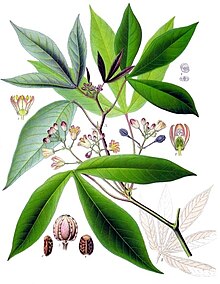
Back Broodwortel Afrikaans بفرة Arabic بفره ARZ Manihot esculenta AST Maniok Azerbaijani Kaséla BAN Balinghoy BCL Маніёк Byelorussian Маниока Bulgarian Maniok Bislama
| Cassava | |
|---|---|

| |

| |
| Tuber (waxed) | |
| Scientific classification | |
| Kingdom: | Plantae |
| Clade: | Tracheophytes |
| Clade: | Angiosperms |
| Clade: | Eudicots |
| Clade: | Rosids |
| Order: | Malpighiales |
| Family: | Euphorbiaceae |
| Genus: | Manihot |
| Species: | M. esculenta
|
| Binomial name | |
| Manihot esculenta | |
| Synonyms[1] | |
| |
Manihot esculenta, commonly called cassava (/kəˈsɑːvə/), manioc,[2] yuca (among numerous regional names) is a woody shrub of the spurge family, Euphorbiaceae, native to South America, from Brazil, Paraguay and parts of the Andes. Although a perennial plant, cassava is extensively cultivated in tropical and subtropical regions as an annual crop for its edible starchy root tuber, a major source of carbohydrates. Cassava is predominantly consumed in boiled form, but substantial quantities are processed to extract cassava starch, called tapioca, which is used for food, animal feed, and industrial purposes. The Brazilian farinha, and the related garri of West Africa, is an edible coarse flour obtained by grating cassava roots, pressing moisture off the obtained grated pulp, and finally drying it (and roasting in the case of both farinha and garri).
Cassava is the third-largest source of food carbohydrates in the tropics, after rice and maize. Cassava is a major staple food in the developing world, providing a basic diet for over half a billion people. It is one of the most drought-tolerant crops, capable of growing on marginal soils. Nigeria is the world's largest producer of cassava, while Thailand is the largest exporter of cassava starch.
Cassava is classified as either sweet or bitter. Like many other roots and tubers, both bitter and sweet varieties of cassava contain toxins; the bitter varieties contain much larger amounts. Cassava must be properly prepared before consumption, as improper preparation can leave enough residual cyanide to cause cyanide poisoning. The more toxic varieties of cassava have been used in some places as famine food during times of food insecurity. Farmers often prefer the bitter varieties because they deter pests, animals, and thieves.
- ^ a b "Manihot esculenta Crantz, Rei Herb. 1: 167 (1766)". Plants of the World Online. Board of Trustees of the Royal Botanic Gardens, Kew. 2022. Archived from the original on 11 November 2022. Retrieved 11 November 2022.
- ^ "Manihot esculenta". Germplasm Resources Information Network. Agricultural Research Service, United States Department of Agriculture. Retrieved 4 January 2014.
© MMXXIII Rich X Search. We shall prevail. All rights reserved. Rich X Search